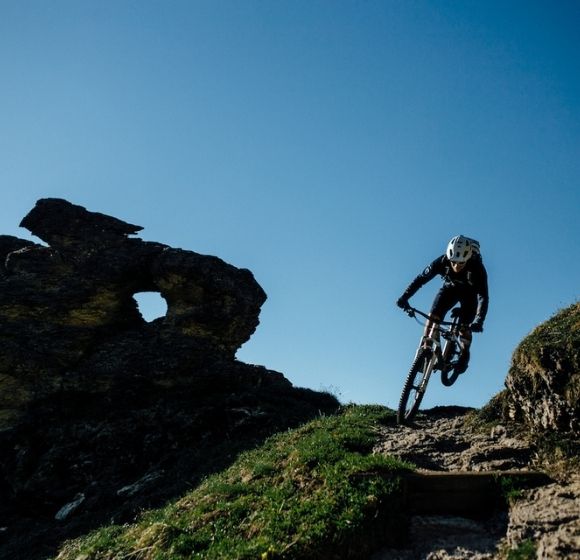
HARALD PHILIPP
Endura's mountain bike adventurer
MOUNTAINS: REAL AND UNREAL
The drive along the valley road west out of Kitzbühel is picturesque, to put it mildly, but Harald Philipp is unimpressed.
“These are not real mountains,” he says, gesturing at the huge, but still grassy slopes that rise either side of the main E45 road.
It is only when we draw closer to his home in Innsbruck, where the rock faces of the soaring Alpine peaks are exposed and forbidding, that his smile becomes knowing. He nods in approval. “These are real mountains.”
“Flow completely merges what I’m doing. Everything becomes easy and playful, even though you’re on the limit of what you can do.”
Philipp is an Alpinist, adventurer, author, film maker, ‘flow’ practitioner and public speaker; a man of many talents.
“I don’t know if I have all those abilities!” he says, laughing at a description in which he is too modest to recognise himself, despite its accuracy. “I have a big creative drive, and the mountain bike is a nice tool for expression.”
Philipp is a rider, above everything else; one who has made a playground of the biggest and most challenging terrain imaginable. His local trails are those that an average rider might see only in his wildest dreams - or worst nightmares.
He scares the life out of photographer Sean Hardy by rolling down an exposed ledge on the 1,996m Kitzbühelerhorn on his front wheel, laughing like a drain. It is plain that he does not regard even the signature peak of the mighty Kitzbühel Alps as a challenge.
CHALLENGE AND ADVENTURE
As an Alpinist, Philipp has followed his own path. He is quick to point out that he did not create mountain bike adventuring, though he might accurately be described as a child of the Alps, having travelled with his parents for rock climbing each summer and ski touring every winter, from the family home in Bavaria.
Philipp began mountain biking aged 11, starting with XC and marathon, before following friends into DH and freeriding, and later DH marathons. Mountain biking was a means of escape during a childhood spent in central Germany (“where there are no mountains, which was really bad!”) before moving to Innsbruck as soon as he finished school.
“I really like public speaking, but for me, it’s very important not to stand on the stage and say, ‘Look at me.’ It really is to give the audience something that they can take with them.”
Innsbruck has been an important part of Philipp’s life ever since. Located in western Austria, he estimates that the Tyrolean capital is home to 1,000 Enduro riders. Although the MTB scene is large, Philipp says it is not friendly, blaming a ski-like culture of riders claiming lines as their own discovery. This doesn’t sit well with an adventurer whose stated aim is, “to ride with people, not against them.”
“When it comes to adventures, and adventurous riding, to me, it doesn’t need to be a competition,” he says. “It’s a challenge, of course, and you can accept it as a team, but I figured out that if you have a good experience, it’s always better if you share it with others. That’s just my philosophy. I’d like to be a role model for riders who don’t have ambitions to race; for those people who just go out and enjoy being on their bikes.”
It’s hard to think of anyone better qualified. Philipp’s riding exploits are fast, skilful and courageous, even if they are not timed, or taken wheel-to-wheel. Instead, he has honed a skillset optimised for the great love affair of his life: mountains.
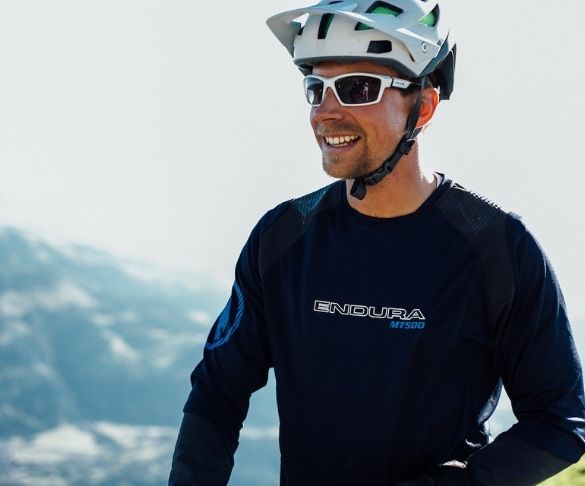
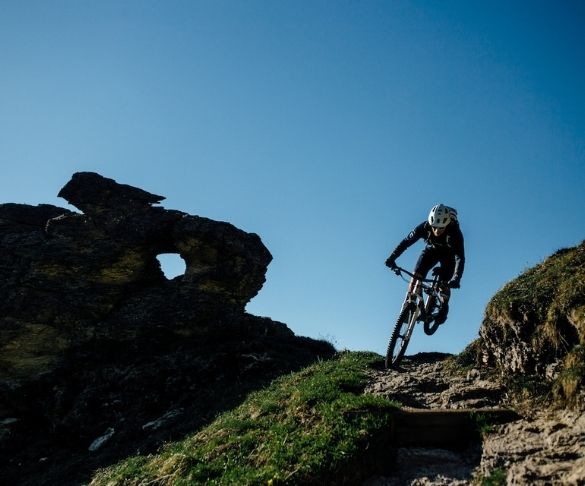
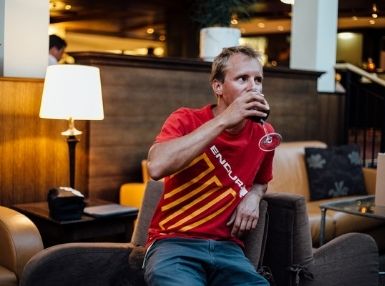
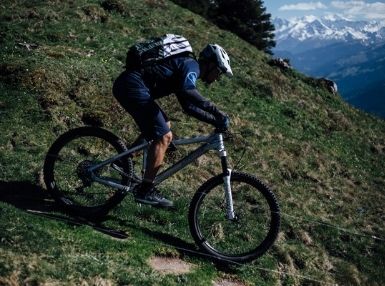
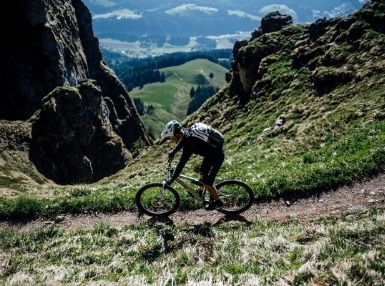
Precision is the quality he values most, and watching him navigate singletrack trails cut into the side of a mountain, with a sheer drop to his left or right, it’s easy to see why. Indeed, exposed ledges are Philipp’s speciality, and if he regards the Alps as a playground, even he recognises its inherent danger and the need - sometimes - to save the adrenalin high for another day.
“I want to be as precise as possible. I often ride trails that are very exposed; very dangerous. I really need to know when not to ride - when to step back. I might be capable, but today I don’t want to do it, so I step back. Touch wood, last year I didn’t have a single crash in the whole season. This year, I’ve had one already, which is out of the ordinary. Normally I have one, or a maximum of two crashes a year - always in simple turns!”.
“I found it interesting that while mountain bikers use the term ‘flow’ to mean a fluid track or fluid riding, scientists use that term to describe a psychological phenomenon.”
He cherishes the narrow pathways, created over centuries for a range of illicit tasks, from hunting to smuggling to warfare, but nowadays used and maintained for nothing more adrenalin-fuelled than hiking. Philipp believes that by riding the trails, he is ‘reinterpreting’ them. “We don’t build trails for mountain biking in the Alps,” he says with a smile. “We just have them.”
“In the Alps, I like to find something in the trails that wasn’t intended when they were built. If you go to the Dolomites, there’s a trail that was built for transporting cannons and troops over mountains in WWI, but to go there with a mountain bike and find something completely different in that trail – to find a rhythm in it, and be the first person to have that interpretation of the trail - that’s very interesting to me.”
ALPINE RULES
Naturally, he does not buy the idea that singletrack trails should be used only by hikers, though he is keen to highlight the need for mutual respect. Often, he will start a ride very early in the morning, or head to the trails in the evening, descending in the dark, rather than compete for trail space with walkers.
Etiquette is something one learns by doing, he reasons. Respecting the trails, as well as those who use them, is second nature for one whose earliest childhood memories involve the Alps. He talks of adding a “meta layer” to his riding experience. “What’s my impact here?” he asks, rhetorically.
“I want to be as precise as possible. I often ride trails that are very exposed; very dangerous. I really need to know when not to ride - when to step back.”
“You have to imagine in the Alps that this whole trail network is completely used and maintained for hikers. There are a lot of mainly theoretical problems going around: ‘We need to divide them: no bikers on hiking trails’. And my idea is that it actually works pretty well to share those trails, and I have to merge in there.
“It’s my interpretation to use those trails for mountain biking, but I can't be arrogant or selfish about it. I need to respect that there are others [who use them]. Knowing and loving those trails, it would be unfair to destroy them. Part of it is my Alpine upbringing. When I was a child, going to the Alps with my mother was playing; it was a game. I still feel like I’m playing now, only I have a mountain bike as a toy!”
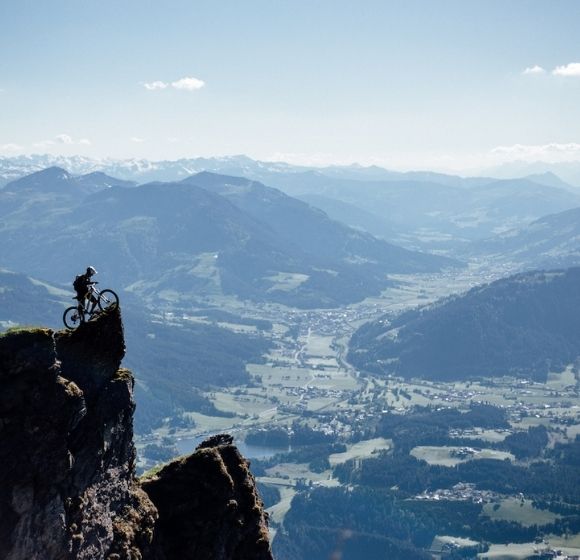
Precision is the quality he values most, and watching him navigate singletrack trails cut into the side of a mountain, with a sheer drop to his left or right, it’s easy to see why. Indeed, exposed ledges are Philipp’s speciality, and if he regards the Alps as a playground, even he recognises its inherent danger and the need - sometimes - to save the adrenalin high for another day.
“I want to be as precise as possible. I often ride trails that are very exposed; very dangerous. I really need to know when not to ride - when to step back. I might be capable, but today I don’t want to do it, so I step back. Touch wood, last year I didn’t have a single crash in the whole season. This year, I’ve had one already, which is out of the ordinary. Normally I have one, or a maximum of two crashes a year - always in simple turns!”.
“I found it interesting that while mountain bikers use the term ‘flow’ to mean a fluid track or fluid riding, scientists use that term to describe a psychological phenomenon.”
He cherishes the narrow pathways, created over centuries for a range of illicit tasks, from hunting to smuggling to warfare, but nowadays used and maintained for nothing more adrenalin-fuelled than hiking. Philipp believes that by riding the trails, he is ‘reinterpreting’ them. “We don’t build trails for mountain biking in the Alps,” he says with a smile. “We just have them.”
“In the Alps, I like to find something in the trails that wasn’t intended when they were built. If you go to the Dolomites, there’s a trail that was built for transporting cannons and troops over mountains in WWI, but to go there with a mountain bike and find something completely different in that trail – to find a rhythm in it, and be the first person to have that interpretation of the trail - that’s very interesting to me.”
ALPINE RULES
Naturally, he does not buy the idea that singletrack trails should be used only by hikers, though he is keen to highlight the need for mutual respect. Often, he will start a ride very early in the morning, or head to the trails in the evening, descending in the dark, rather than compete for trail space with walkers.
Etiquette is something one learns by doing, he reasons. Respecting the trails, as well as those who use them, is second nature for one whose earliest childhood memories involve the Alps. He talks of adding a “meta layer” to his riding experience. “What’s my impact here?” he asks, rhetorically.
“I want to be as precise as possible. I often ride trails that are very exposed; very dangerous. I really need to know when not to ride - when to step back.”
“You have to imagine in the Alps that this whole trail network is completely used and maintained for hikers. There are a lot of mainly theoretical problems going around: ‘We need to divide them: no bikers on hiking trails’. And my idea is that it actually works pretty well to share those trails, and I have to merge in there.
“It’s my interpretation to use those trails for mountain biking, but I can't be arrogant or selfish about it. I need to respect that there are others [who use them]. Knowing and loving those trails, it would be unfair to destroy them. Part of it is my Alpine upbringing. When I was a child, going to the Alps with my mother was playing; it was a game. I still feel like I’m playing now, only I have a mountain bike as a toy!”
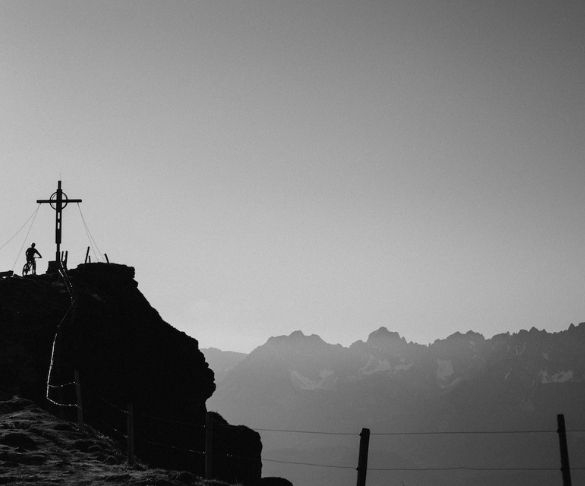
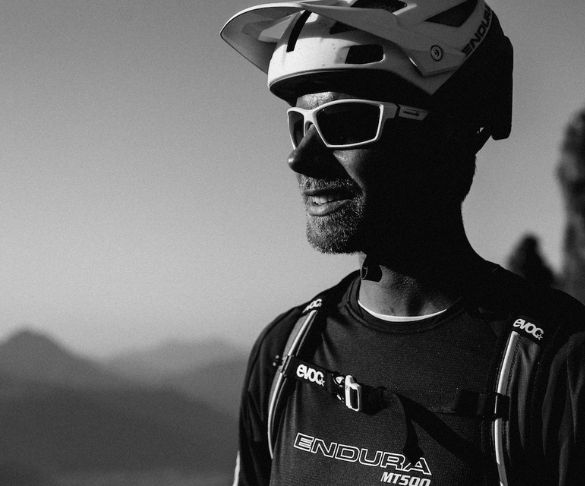
LIFE STUDY
Philipp describes his school career with a sheepish laugh, choosing to highlight the ten trips he made to Lake Garda in his final year of study, rather than any academic success. But he is unable to conceal a natural intelligence that has made him an author, lecturer, and film maker, as well as mountain bike adventurer. Exams might not be his thing, but creative spirits rarely flourish in the classroom.
Philipp’s embrace of ‘flow’ embodies his philosophical approach to riding. He co-written a book (with outdoor scientist Dr Simon Sirch, who had researched the phenomenon) and held a speaking tour to spread its virtues: essentially, that losing oneself in the moment to give everything to the task at hand can be deeply fulfilling, in a practical and emotional sense.
“It’s essential to experience ‘flow’. I think focusing on things, doing them fully and nothing else, is a really nice shortcut to good performance and a good feeling.”
“It’s essential to experience flow,” Philipp maintains. “I think focusing on things, doing them fully and nothing else, is a really nice shortcut to good performance and a good feeling. Flow will definitely stay with me. To me, it feels like an upgrade. When I started on this bike-mountaineering thing, I was very much focused on going up - following steeper trails, even if they led to a dead end. Flow gave me back some balance; a wider view.”
Flow is not exclusive to mountain biking, of course, or even cycling. Artists, musicians, and creative thinkers of all kinds benefit from its practice, Philipp believes. He says he last ‘reached flow’ during an intense two-day period researching his next project (more of which later).
“I found it interesting that while mountain bikers use the term ‘flow’ to mean a fluid track or fluid riding, scientists use that term to describe a psychological phenomenon. I read up on the science and found that several people had written books about it.
“I thought, ‘This is exactly what I experience when I’m mountain biking!’ It’s a big story to tell, and not an easy story to summarise for a magazine. That’s why it turned into a book and into a lecture. In the lecture, I have two hours to take the audience into that phenomenon.”
PUBLIC ADDRESS
For one who “just about” finished his final school exams, Philipp has embraced cerebral pursuits as easily as descending an Alpine trail. He readily admits that writing ‘Flow: why mountain biking makes you happy’ was a shared, two-year effort, with Sirch presenting the scientific aspect as context to a riding story, each of which was filmed.
The lecture, however, while based on the structure formed in the ten chapters of the book, is very much Philipp’s project. Indeed, it was from Sirch’s email on the rider’s previous lecture - a detailed email filled with new perspectives - that the book project started.
Public speaking suits Philipp just fine, even if many would find the experience intimidating. He is clear on its purpose: to inspire the audience, rather than to satisfy his ego. There is a mix of philosophy and mountain biking, and a focus on lighting a fire within those who come along to listen.
“‘Flow’ is a big story to tell, and not an easy story to summarise for a magazine. That’s why it turned into a book and a lecture.”
“I really like it, but for me, it’s very important not to stand on the stage and say, ‘Look at me. I’m really awesome and now I feel great about it.’ It really is to give the audience something that they can take with them. Most people come to the show to see me biking, and when they leave, they think about themselves. That’s the really interesting aspect for me.”
Philipp explains that the lecture has different levels. For the action addict, there is plenty of riding footage, and to this degree, the lecture works as entertainment. However, there is another, deeper level, for those sufficiently interested to find it.
“There is a red thread going through the sections, and some dramatic changes,” Philipp explains. “I really researched how to tell that story. It becomes more and more meta …”
He pauses.
“I don’t want to say too much more. I would love to hold a lecture in the UK at some point!”
The UK is one of the few locations where Philipp hasn’t delivered the Flow lecture. Vancouver (twice) and venues “all over Europe” have hosted him, and he has made contact with the Sheffield Doc/Fest, but Britain is currently missing out. “I’ve also been in touch with a weird Welsh festival, where I couldn’t spell the name,” he adds, with a smile.
The truth is Philipp needs logistical support to put his show on the road. He gives 40 talks each winter - a relentless schedule - and the business of booking halls and other practical necessities can be time consuming. Interested parties can contact Endura…
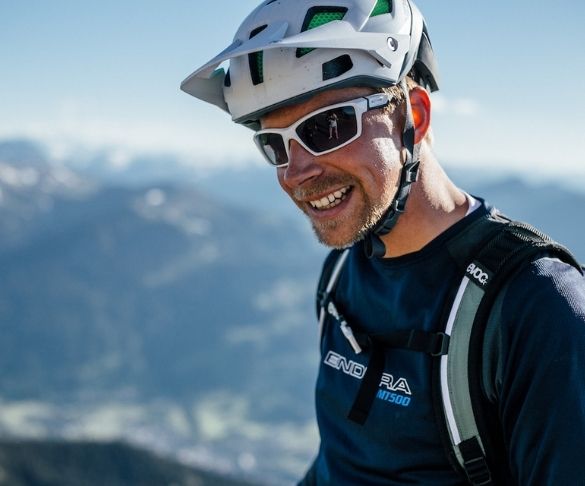
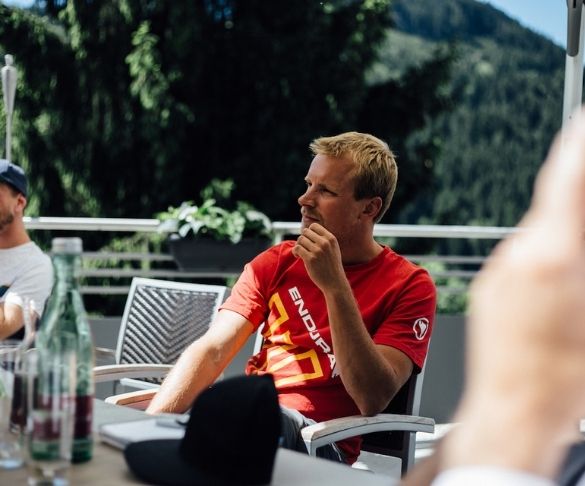
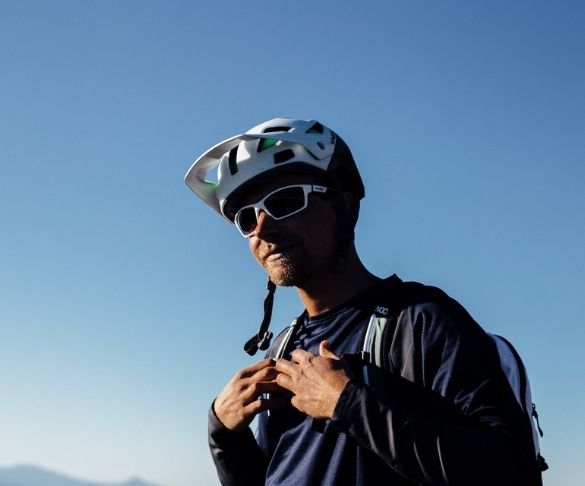
WELCOME TO THE CLAN
Philipp’s is a restless spirit and he has several projects in development. One involves a week-long ride from Chamonix to the Maritime Alps with food, but no money. The catch? The ride will be made on e-bikes, with no means of recharging. Philipp and his crew will be forced to beg, borrow or steal electricity. Digging gardens in return for an energy top up is already on his list.
The other involves a return to the Himalayas, where a previous visit was derailed by an unforeseen difference in trail building culture. Those marked on maps, he discovered, are long, wide, stepped and, “...not very interesting to ride!”.
“When it comes to adventures, and adventurous riding, it doesn’t need to be a competition. If you have a good experience, it’s always better to share it with others.”
Having noticed “shit loads of smaller paths, for farming and shepherding”, Philipp is now putting in serious hours with Google Earth and drawing his own maps. Can we add cartographer to his list of talents?
“I don’t know how precise they’re going to be!” he says, laughing. “We will see.”
While Philipp is at pains to stress that he did not invent mountain bike adventuring, or create ‘flow’ philosophy, he is surely one of a kind within his sport. He has the skills to ride with the best, even if the idea of competition holds precisely no interest for him. Instead, his approach to riding is philosophical, separating him from the average ‘horn’ gesturing, GoPro addict.
If he is content to ride his own path, then this by itself makes him an ideal fit for Endura. Indeed, it was the brand’s publicly-stated philosophy of Renegade Progress that drew him in. Products like the MT500 jacket and helmet have already shown him that there is more to Endura than a strapline.
Philipp’s talk of ‘reinterpreting’ centuries old trails, and of finding his own ‘rhythm’ in locations as diverse as the Dolomites and the Maritime Alps, speaks of a rider who gives a much of his soul to the business of riding a mountain bike as his legs, even if the adrenalin rush of descending a sheer Alpine rock face must take some beating.
“Flow completely merges what I’m doing,” he says. “Everything becomes easy and playful, even though you’re on the limit of what you can do.”
The limits of riding among the soaring peaks of the Tyrol must be challenging, but Philipp - laid back and unpretentious, despite the breadth of his abilities - is unphased by the challenge. Dropping in from the upper slopes of the Kitzbühlerhorn is all in a day’s work for a rider who embodies Endura’s spirit of Renegade Progress.
Alpinists, it seems, are natural born mavericks. Welcome to the clan, Harald.
FOOTNOTES Words by Timothy John. Images by Sean Hardy Kitzbuhel, Austria
© 2021 ENDURA